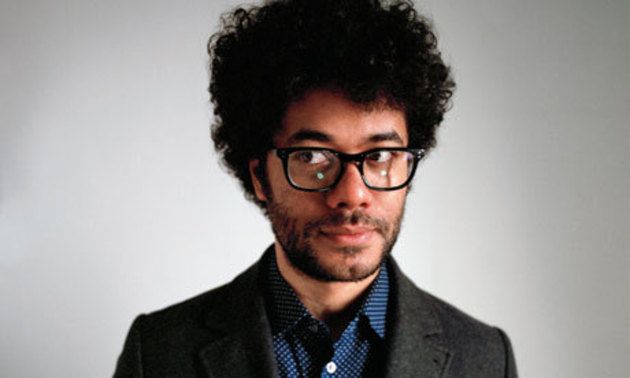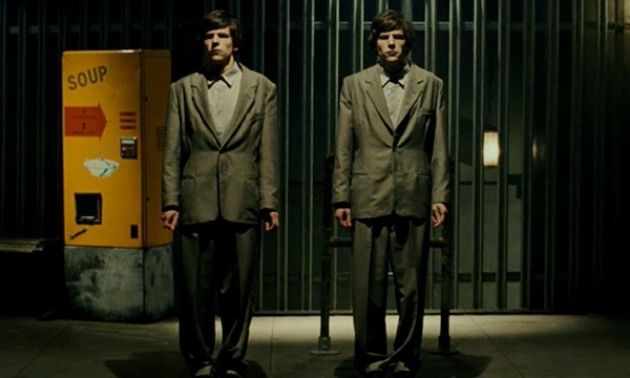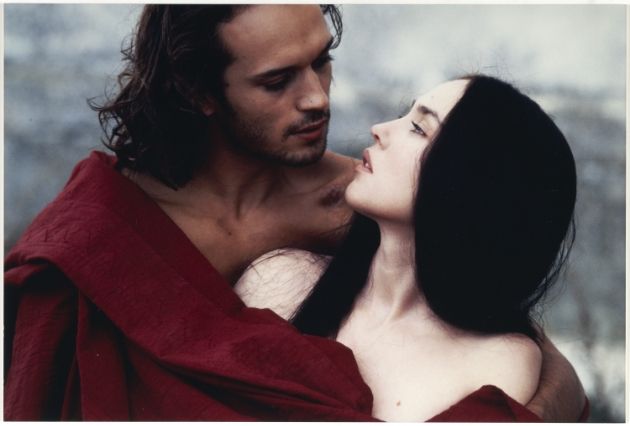
Writer, actor, director, gameshow host and author, British Comedian Richard Ayoade is some sort of a renaissance man. His directorial film debut, Submarine, a rare teen romance from British Isle in years, delighted audiences with its wry humor and tender depiction of youth. His new film, The Double, based on Dostoevsky's novella is wildly different both in themes and style and great leap forward in filmmaking. In person, Ayoade is reserved and soft spoken but one can sense his fierce intelligence underneath wild curly hair and behind those silly black rimmed glasses.
Even though you write a lot of contents for many of the projects you are involved in, those two films you've made - Submarine and now The Double, are based on someone else's writing. I wonder how you choose what films to make.
Well, in the case of Submarine, I've been doing music videos for Warp (Records) Films. They just optioned the book (written by Joe Dunthorn) and they wanted me to look at it. With that, I always loved the teen genre which didn't exist in England for a long time. I was obsessed with Dawson's Creek, the first, Kevin Williams season. After that, I had some issues with it. And I love The Graduate and that kind of coming of age movies. Then I read Joe's book, and I was happy to do that film. Around the same time is when I met Avi (Korine, brother of Hamony) and I read his script (for The Double) when he came by Alcove who produced this. They worked with Hamony Korine (Trash Humpers) and met Avi through doing that. Again I just really liked the script. I guess that's the only script I've read that I really have gone for. And we ended up writing together later. Especially on this, it was really enjoyable working, co-writing together with Avi. With Submarine I wrote on my own, even though Joe was a resource who I can speak to. The Double was great because Avi is such a good writer and I like him so much personally. I do like working with people.
You wouldn't think Dostoevsky as a funny writer…
Many would think that but he is. Notes from Underground is really funny I think. The Double is funny. There is sense that his writing is very weighty, serious and important. He is those things because he has this amazing psychological depth that goes very deep. He tackles very deep sort of relationships in people in extremes. But he manages also to prick people's vanity and pomposity in a way that is very funny. Yeah, it's his name that sounds serious. If he was called Maury.... (I crack up) You'd think he's funny. Tony Maury.
Did you grow up in London?
I was born in London. But I grow up in this town near Ipswich, outside London, very small--
I'm just trying to figure out because your sensibility and humor is very different. So I'm wondering how your growing up in a small town shaped your sensibility. Can you tell me your childhood a bit?
Hmm. I am an only child. I had a very fortunate childhood. Ehm, no real dramatic incidents of any kind really…. But I read quite a lot and was quite solitary. Yeah I always liked reading. My dad fixed television for living, so because of that I was really weary of watching too much television. I didn't watch to much TV until I was quite older. I was always interested in writing, but I didn't watch a lot of films, I wasn't really one of those people.
Are there any specific influences that attribute to your sense of humor?
I don't know. I can only sort of say things I really like, but influences... it's hard to say. I like Woody Allen and Richard Pryor who are relatively, unassailably great people. There are million people I like… Peter Cook, and stuff that Chris Morris did, like Day Today, Coogan and Alan Partridge and Iannucci and that whole set of people are very important for people of my age I think. Chris Morris is really big for me and John Oliver because we really love Morris's stuff.
How was directing Morris in The Double?
By that stage I've known him for a while. It was just great! He is so unique! You are just so excited to start it. And that's a really nice feeling. All these great actors, you just want to get going on them and see what they are going to do.
I love him so much as a performer and he doesn't perform very often. So it was great to see him and Jesse. Also great to see how much Jesse enjoyed him. Because Jesse isn't a big consumer of media.
So I've heard.
It was so fun to see Jesse trying so hard not to laugh, and to see Jesse encountering all these different people like Tim Key and Chris O'Dowd… that kind of hysteria was good for us because Jesse was kind of punch drunk among these people who were saying all these awful things but very funny at the same time.
So most of the cast is comprised of the actors who were in Submarine, except Eisenberg and Mia Wasikowska who are big stars now. Was it any different directing them (Eisenberg and Wasikowska)?
I wouldn't say there is. I think it really comes down to individual personality. In many ways, they are less defensive. There are some actors who don't think they haven't had too much success in their careers that they could be defensive and that can be inhibiting. But no, I mean, they are incredibly brilliant to work with and there is no difference at all. I mean, I think it was the only film where an actor asked not to have a trailer because he was never in it. You know, we are in an industrial park in the middle of nowhere, one hour outside London at night. This was no fancy place.
It's interesting to see how stylistically different the movie is from Submarine. A lot of night scenes, confined spaces, moody and atmospheric. How was the shooting this one different for you and your DP Nik Wilson?
Submarine was very quick. Just on a basic level we could do a number of setups a day. The Double, everything was lit, so it went slower. But that provided for us to rehearse a lot during the day between setups. It just felt what's appropriate for the material, really. That was the way to go.
I mean, I've always thought Woody Allen as a visual director, as well as… you know. Just think of the great variety of style from Stardust Memories or Husbands and Wives to Zelig, you know, any number of films with extremely different style. I think he receives literally little to no recognition as a visual stylist even with his incredible ability. Each one is goes with what its material suggests. An approach like that - rough approach in Husbands and Wives, I feel is completely appropriate. There is a slightly more stately feel in, say, Sweet and Lowdown…. So he is a director, if you try to think of a style, you go maybe long takes, possibly? But then again we don't remember about Stardust Memories because of jump cuts or Zelig because of long takes. I don't know what his hallmark style is.
That's very true.
But it always feels like him and his voice, but it comes from what the story is about and how to best support it. I'd like to be like that and go where a story suggests.
I read it in one of your interviews that in everything you do, you approach it as a newcomer, because of different circumstances and different environment you are in.
I think so. Also because whenever you feel you can rely on something working out and it never does. But if you risk something without fully knowing how to do it, it often ends up turning out best. So I think it just practically always is-- the situation never seems to repeat itself, you are always in different spots- different places, different actors. Even with the same actors you've got different roles and different set of problems. So it always is. I think filmmaking is one of those things that uniquely feels difficult to learn that much from each time. I think if you were maybe John Ford, making number of films you might have that kind of authority but if you make something every few years, I don't think you will get that kind of mastery. I mean how many films John Ford did before the Searchers? 50 or 60...?
So maybe in twenty, thirty years you will have a…
Two more films. (we laugh)
The look of the film is very 80s retro sci-fi feel to it. Very reminiscent of Terry Gilliam's Brazil. Is it something you came up with?
It's a combination of things. The idea of it in the script was kind of modern metropolis which was full of people teaming, which I felt oddly, have been done by a quite number of films whether it was King Vidor's The Crowd or Modern Times or The Apartment, you know, those small-man-in-a-big-city movies. I wanted it more feel like a quite decrepit, unpopulated city, that is sort of alternate universe, more like, Edward Munch town where everyone's old and there aren't very many people. I guess as soon as there is kind of antiquated bureaucracy that became Gilliam's calling card or seems to be, although I view him as somebody much more satirical or rather Fellini-esque. Probably my favorite film of his is Fear and Loathing in Las Vegas. Brazil is not what I'm really conversing with. I've seen it as a teenager and haven't seen it since. To us, for the theme's sake, I was thinking more of In the Mood for Love, more to do with lonely places, lonely corners of office space or more like Aki Kaurismaki or Eraserhead even.
OK, something more to do with confined space.
Yes, there is not a lot of bustle. That was more kind of feeling that…again, that feeling was suggested by the book. There is something funny of it being described as Kafkaesque. Because linearity of time is on Dostoevsky's side. (laughs) HE DID DO IT FIRST. It's this quite similar thing that he came up with in the middle of the nineteenth century where this kind of office bound clerk in a strange kind office where you don't quite know what they do and the doppelgänger. It all comes from the book.
I guess I have to read the book now.
Yeah the book's great.
I know you are busy but is there any project you are working on that we have to be aware about?
I've written a book that is going to come out which is like a fiction book but in non-fiction form. It's about film but like a kind of funny book.
What is it called?
Well, that's under negotiation. we are not sure what to call it yet. There are few titles kicking. Part of it will definitely be something like Ayoade on Ayoade like Kieslowski on Kieslowski, but it's going to be a funny book.
It will be released on VOD and theatrically on Friday, May 9 in New York (and LA) at the Landmark Sunshine Cinema. A national rollout will follow.


